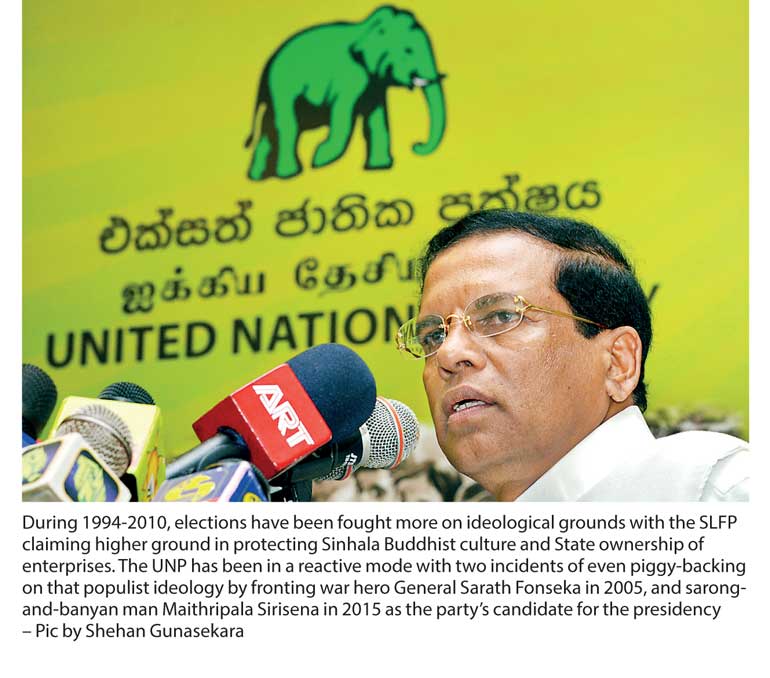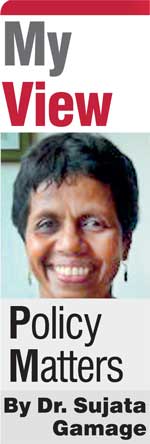Tuesday Apr 15, 2025
Tuesday Apr 15, 2025
Friday, 6 April 2018 00:10 - - {{hitsCtrl.values.hits}}

 With the No-Confidence motion behind it, the United National Party (UNP) is promising deep reforms in the party. Unless the party recognises that it has a branding problem, and search far and wide for an endearing brand or an identity that counters protectionist and racist ideology of the opposition, it would not be able recover the faith mandate it received in 2015 to lead a liberal democratic agenda.
With the No-Confidence motion behind it, the United National Party (UNP) is promising deep reforms in the party. Unless the party recognises that it has a branding problem, and search far and wide for an endearing brand or an identity that counters protectionist and racist ideology of the opposition, it would not be able recover the faith mandate it received in 2015 to lead a liberal democratic agenda.
Since S.W.R.D. Bandaranaike walked off with the Sinhala Buddhist part of the United National party in 1954 to form the Sri Lanka Freedom Party (SLFP) supposedly representing Sangha, Swabhasha teachers, Ayurvedic physicians, farmers and workers, the UNP has been flailing around for an identity.
During 1956-1977, the UNP was trying to counter its image as the party of comprador capitalists by offering two free measures of rice and other gimmicks. But the socialist Sinhala Buddhist image of the SLFP ideology held sway, judging by the length of time each held on to power during that period.
The UNP managed to break the dominance of the SLFP when the closed economic policies of the SLFP put the country into a near starvation situation, and the party managed capture power with a landslide and hold onto power from 1977 to 1994.
Notwithstanding the 1983 anti-Tamil pogrom which happened in its watch and the infamous referendum to extend the life of the Parliament, the party should be credited with opening the economy, accelerating Mahaweli Development and other key achievement that lifted the country economically. Yet the popular culture is steeped in the notion that opening of the economy in 1977 is the root of all evil.
During 1994-2010, elections have been fought more on ideological grounds with the SLFP claiming higher ground in protecting Sinhala Buddhist culture and State ownership of enterprises. The UNP has been in a reactive mode with two incidents of even piggy-backing on that populist ideology by fronting war hero General Sarath Fonseka in 2005, and sarong-and-banyan man Maithripala Sirisena in 2015 as the party’s candidate for the presidency.
Judging by the sentiments expressed at the Parliamentary debate on the no-confidence-motion, the UNP has come to understand the limits of these piggy-backing exercises. It is now a political imperative that the Party presents a sellable ideology on its own.
The anti-liberal ideology is clearly occupied by the Sri Lanka Podujana Peramuna (SLPP), the new reincarnation of the SLFP. UNP has no alternative but to stay close to its liberal democratic ideals, but how is the question.
Liberal democracy ideals are in retreat across the world. David Brooks (NYT, 2/4/2018) in explaining why he would call Vladimir Putin the most influential man in the world, says that, in times of anxiety and distrust, it’s much easier to sell: (1) Clear centralised authority than dispersed, amorphous authority of a Constitution or set of norms, (2) Cynicism than Idealism and (3) Us/them distinctions than tolerance for cultural diversity. Putin tops all world leaders in all three regards he concludes.
In our own little corner of the world, with national anxieties no less in proportion, the recent Local Government elections demonstrated that a plurality of voters (not a majority though) (1) love an autocratic leader like Mahinda Rajapakshe, though he may have little regard for law and order; (2) are cynical in that they shrug off corruption as a necessity and disdain good governance achievements; and (3) identify minorities in this country as the Other.
To sell the counter-ideology of liberal democratic values, the UNP has to show that institutions work better than autocrats, good governance brings tangible benefits and the Other is not other Sri Lankans of a different culture or a race, but competitors outside the shores. This counter ideology does not easily lend itself to posters, banners or theme songs. Liberal democratic ideals, can empower individuals, increase competition to bring down prices, lift people out of poverty etc., but it is does not lend itself easily to a culture expressed through popular music, arts and props for campaigns.
In contrast, think of a rally to save a glorified leader from an imaginary electric chair or to save the motherland from a trade agreement. Popular culture, dominated by protectionist professionals led by university teachers, doctors and other senior government officials as well as petty Government officials and teachers, and last but not least, Buddhist clergy, rises to support. A ‘Sinha-le’ decal would appear overnight on trishaws. Visharada Amaradeva’s music and lyrics about the village, old glory, motherland, would lull people as they wait patiently for leaders to arrive, perennially late.
While the anti-liberals have a lock on these groups and their cultural norms, the good news is that rest of the population is larger in size. With millions of workers with foreign employment experience coming back home, the US/Them in a local sense would be a harder sell. They have seen what is out there and are more inclined to see minorities as fellow Sri Lankans. How to make these people champions of a Sri Lankan identity that rises above ethnic identities is the question.
Political parties are proven channels of selling an ideology to the grass-roots and receiving feedback from the grass roots. In 1860, when Abraham Lincoln received nomination for President in the second ever convention of the Republican Party, delegates poured in from all the states to Chicago. Lincoln was the dark-horse candidate from the back waters of Illinois, and William Seward form New York and others were more favoured. The middle ground offered by Lincoln on the state of the union and slavery won the day through three rounds of voting and Lincoln went on to become the nation’s 16th president and one of the greatest statesman ever.
Since then political conventions deteriorated with decisions made in smoke-filled rooms, but redefined after the famous protests during Democratic Party convention in Chicago in 1968. Now the USA has a participatory process of primary elections, state by state, to pick a presidential candidate for each Party. (As an aside, this party system in the USA has gifted the world with a Donald Trump, but that is another story.)
In Sri Lanka, we probably never had any proper political parties. What we seem to have is the capture of a party symbol by an individual, and the selection of executive committees in rather opaque processes that perpetuate the power of the incumbent leader. The party essentially becomes the property of the leader.
For example, Maithripala Sirisena, the Secretary of SLFP contested against his own party as the common candidate of the rival party in 2015. Had he lost, as he himself said, he would have found himself six feet under. Since he won, the Chairman of the SLFP offers the leadership – as if it is his private property – to the man who betrayed the party, apparently for certain favours in return. Sirisena accepts the post without a blush. A true political party would have expelled Sirisena and elected a new leader. The UNP too has plenty of its own share of undemocratic practices.
If taken seriously, parties are ways of taking an ideology down to a people or formulating an ideology through the participation of the members. On the other hand, for a group of people who want to ride to power through nationalism, religious intolerance, protectionism and other populist ideas, they don’t need internal party democracy. All they need is a shell of a party and ride to power on the coattails of populist leader. That latter mode of operation is already owned by the opposition to the UNP. The UNP has no choice but build the party from the ground up as a proper political party. Then they can use the party mechanism to rally party-faithfuls as advocates for the party ideology.
Greece may be the original home of democracy, but it took four millennia or more of intense debate and struggle to stabilise democracy in the Western world. While Eastern philosophers were looking to change the individual according to the teachings of the Buddha, Confucius or the Gita, Western philosophers from Hobbes, Locke, Kant and Mill to Rawls have been engaged in more practical issues of how to govern and be governed.
The civil war and the continued friction between the King, the Church and the Parliament in UK formed the backdrop for the works of both Thomas Hobbes (1588-1679) and John Locke (1632-1704). Their philosophical deliberations on government and governing continued with Immanuel Kant (1724-1804), John Stuart Mill (1806-1873) and John Rawls (1921-2002), with at least one philosopher for each millennium. These philosophers influenced and were influenced by the political upheavals and periods of stability in their times.
In essence, liberal democracy in the West grew along with an evolving philosophical foundation, beginning with autocratic ruler theory in 1600s. As political scientist summarised: “Human life then was fundamentally unstable and dangerous. Without a common political power [Hobbes] believed that cooperation was impossible and that human sociability would inevitably result in the most savage of wars. In response, Hobbes set out to develop a science by which a potent political authority could be established, and from which a lasting peace might endure. Hobbes named this authority the ‘Leviathan,’ or a strong leader.”
Here in the East, a fratricidal Mughal empire in India and a cruel and treacherous Kandyan kingdom in Sri Lanka were predecessors of liberal democratic values that were transplanted in the continent by the British. In terms of preparedness of the populace we might as well have been in Hobbesian times.
There are many problems in the formulation and the execution of the new Mixed Member Proportional method used in the February 2018 Local Government elections in Sri Lanka. Despite these shortcomings, I am sure all would agree that ward level campaigning was a welcome change from the frenzy of collecting votes across an area 10 or even 50 time larger than a ward, in previous elections. An additional benefit of the system is that now each party has a political cell in each of the 8,000+ wards in the country. What better starting point than that to build our political parties from the bottom?
Hazan and Rahat (2010) in their book titled ‘Democracy within Parties’ introduce the notion of a ‘selectorate’ which consist of the personnel in the party who make decisions on candidates to be presented to the ‘electorate’. According to Hazan and Rahat, the best selectorate would include grass-root party activists, mid-level leaders and national leaders.
Recent local elections provide the backdrop to develop a balanced ‘selectorate’ for the UNP or any political party for that matter. For example, for the recent local election each party had to come up with a candidate list for each of the local council for a final set of 8,000+ candidates at ward level and 40% more. With two more delegates for each ward in the country, each major party will have a delegate base of about 40,000 delegates. A sufficiently representative base indeed to brainstorm and receive inputs regarding an endearing identity for the UNP, for example.
What an opportunity to build a truly liberal democratic party with grassroots support.